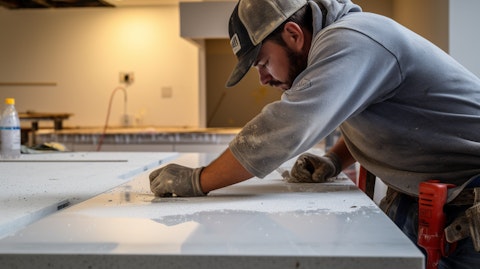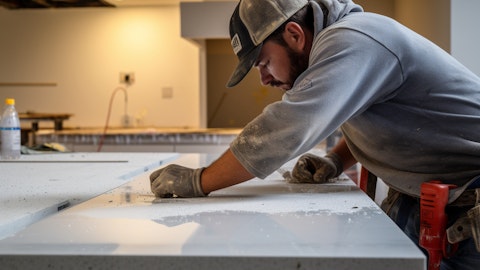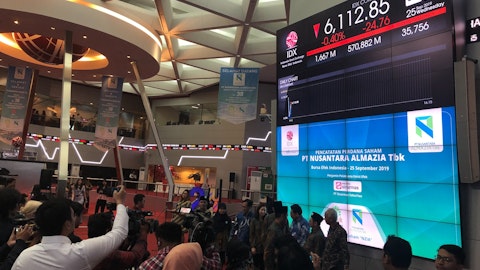Caesarstone Ltd. (NASDAQ:CSTE) Q4 2023 Earnings Call Transcript February 21, 2024
Caesarstone Ltd. misses on earnings expectations. Reported EPS is $-0.28 EPS, expectations were $-0.14. CSTE isn’t one of the 30 most popular stocks among hedge funds at the end of the third quarter (see the details here).
Operator: Greetings, and welcome to the Caesarstone Fourth Quarter 2023 Earnings Conference Call. [Operator Instructions] As a reminder, this conference is being recorded. It is now my pleasure to introduce your host, Brad Cray of ICR. Thank you. You may begin.
Brad Cray: Thank you, operator, and good morning to everyone on the line. I’m joined by of Yos Shiran, Caesarstone’s Chief Executive Officer; and Nahum Trost, Caesarstone’s Chief Financial Officer. Certain statements in today’s conference call and responses to various questions may constitute forward-looking statements. We caution you that such statements reflect only the company’s current expectations, and that actual events or results may differ materially. For more information, please refer to the risk factors contained in the company’s most recent annual report on Form 20-F and subsequent filings with the SEC. In addition, on this call, the company will make reference to certain non-GAAP financial measures including adjusted net loss, income; adjusted net, loss income per share; adjusted gross profit; adjusted EBITDA and constant currency.
The reconciliation of these non-GAAP measures to the most directly comparable GAAP measures can be found in the company’s fourth quarter 2023 earnings release, which is posted on the company’s Investor Relations website. On today’s call, Yos will discuss our business activity and Nahum will then cover additional details regarding financial results before we open the call for questions. Thank you. And I would now like to turn the call over to Yos. Please go ahead.
Yosef Shiran: Thank you, Brad. Good day, and thank you, everyone, for joining us to discuss our fourth quarter and full year results. In 2023, we were able to navigate through challenging macroeconomic, regional geopolitical and regulatory dynamics occurring in our key markets. We have implemented a new strategic plan and initiated significant restructuring actions, which allowed us to accomplish our primary financial objective of generating positive cash flow from operations. We more than delivered on this front as our working capital management and meaningful savings stemming from our global restructuring actions generated positive operating cash flow in four consecutive quarters, totaling $66.5 million. This left us with a solid net cash position of $83.5 million.
Overall, we are executing in accordance with our strategic plan. We believe actions taken during 2023 have set this foundation for an optimized production footprint, better utilization of resources and improved cost structure and realigned workforce, allowing us to capture greater efficiencies and opportunities. We believe that these factors will allow us to enhance our brand, better compete, grow market share and get back to profitability. In regard to driving production cost efficiencies, we are quickly transitioning production to our global network of production business partners. In the second quarter of 2023, we made a decision to close our Sdot-Yam manufacturing facility. And in December, we announced the closing of our Richmond Hill facility.
Following these strategic changes to our operations, we are now sourcing over 40% of our products from production business partners. We expect that percentage to trend up further as we move through 2024. As another result of the closure of these two facilities, we have reduced our spend on CapEx, and we’re able to reduce our workforce by approximately 14% across the organization. In turn, we expect to realize annual cost savings of approximately $20 million in 2024 and $30 million in 2025 on top of the savings that were already realized during 2023. We also maintain our view that we have potential for additional cash inflows as sub leases are executed on the noncancelable long-term lease agreements associated with Sdot-Yam facility and upon the potential realization of our Richmond Hill property.
With all this in mind, we believe that we have a clear strategy in place to reduce our manufacturing cost base and invest a portion of our savings into our brand, sales marketing, R&D and an expansion of our premium porcelain products to reignite profitable growth across the business. Now I would like to provide an update on our Australian market. As we previously announced in December 2023, the Australian federal, state and territory governments announced a joint decision to ban the use, supply and manufacture of engineered stone slabs containing crystalline silica in Australia, including Caesarstone’s quartz-based products. The ban is expected to go into effect on July 1, 2024, in most Australian states and territories. The Caesarstone brand is well known in Australia, and our products have earned tremendous success in the region over the years.
We have been proactive in our approach to supply our Australian market with alternative materials that will comply with the new regulations. By the end of the second quarter of 2024, we will have a full collection of alternative products, which we believe will allow us to retain our position in the Australian market. In conclusion, during 2023, we took significant actions to restructure and stabilize the business. We diverted resources to areas that we believe will allow us to capture profitable growth, all while achieving our goal to further improve our net cash position. While we are pleased with our progress as measured against our initial plan, there is more work to be done. With our restructuring and other cost saving actions, we are prepared to prudently allocate capital back into the business, primarily into our branding and R&D to drive top line growth, margin expansion and profitability.
We believe we have the right global strategy in place to improve our results and drive value to all our stakeholders. Thank you. And I will now turn the call over to Nahum to walk through the details of our financial performance.

Nahum Trost: Thank you, Yos, and good morning, everyone. Looking at our fourth quarter results. Global revenue in the fourth quarter was $128.5 million compared to $159.4 million in the fourth quarter of last year. On a constant currency basis, sales were down 19.6%. The decrease was primarily driven by softer global market conditions particularly in North American renovation and remodel channels, mainly as a result of higher interest rates, which has impacted residential spending. In addition, our sales were impacted by the competitive landscape for our products. In the U.S., sales were down 21.1% mainly tied to softer residential end markets, particularly through third-party distributors. This was partly offset by higher year-over-year sales with big box customers and improved performance in our commercial business.
Canada sales were lower by 13.8% on a constant currency basis, experiencing similar market dynamics as the U.S. but to a lesser extent. Australia sales were off by approximately 8.1% on a constant currency basis, reflecting slower market conditions. The Australian government’s decision to ban quartz slabs did not have an impact on our fourth quarter sales, given the planned mid-2024 implementation of that ruling. In Israel sales were challenged in the fourth quarter, mainly as a result of the war on terror, which has significantly reduced activity in the region. Looking at our fourth quarter P&L performance. Our gross margin was 18.1% for the quarter. Adjusted gross margin was 18.9% compared to 19.7% in the prior year quarter. The year-over-year decrease in margin mainly reflected the impact of lower revenues, unfavorable product mix, higher slow-moving inventory provisions and the increased manufacturing unit cost driven by lower fixed cost absorption due to the lower capacity utilization.
These factors were partially offset by lower sea freight expenses and the benefits of our improved production footprint as we transitioned production to our global network of third-party manufacturing partners. Operating expenses in the fourth quarter were $56.5 million compared to $106.1 million in the prior year quarter, mainly related to a higher onetime non-cash charge in the prior year. Excluding legal settlements, loss contingencies and restructuring and impairment expenses, operating expenses were 24.3% of revenue compared to 22.2% in the prior quarter. The higher percentage mainly resulted from the lower revenues. Adjusted EBITDA in the fourth quarter was $1.4 million compared to $5.7 million in the prior year quarter. The decrease primarily reflects the operating loss and lower gross margin.
Now looking at our full year financial performance highlights. Sales for the full year were down 18.2%. On a constant currency basis, sales were down 17%, mainly due to lower volume, driven by challenging market conditions across our global footprint. Gross margin for the year was 16.3% compared to 23.6% last year. Adjusted gross margin was 17% compared to 23.8%. The difference in adjusted gross margin mainly reflects lower revenues and increased manufacturing unit costs due to lower fixed cost absorption. This was mainly related to lower capacity utilization as we undertook significant restructuring actions within the business during 2023. The unfavorable impact of the underutilized capacity at our plants was partially offset by the benefits of higher ASP, lower shipping costs and improved production footprint as we transition the significant portion of production to our network of third-party manufacturing partners throughout the year.
Excluding legal settlements, loss contingencies, restructuring and noncash impairment expenses we incurred during the year. Operating expenses for the full year were 24.2% of revenue compared to 21.7% in the prior year. Our full year 2023 adjusted EBITDA was a loss of $9.4 million compared to a gain of $51.9 million last year, with the year-over-year change primarily reflecting the lower gross margin and operating loss. Turning to our balance sheet. Caesarstone balance sheet remains solid. As of December 31, 2023, cash, cash equivalents and short-term bank deposits totaled to $91.1 million, with the total debt to financial institutions of $7.6 million. During the fourth quarter, we generated another quarter of positive cash flow from operations of $13.2 million.
For the year, cash flow from operations totaled to $66.5 million, mainly driven by inventory reductions in the quarter and the full year. Our net cash position as of December 31, 2023, was $83.5 million compared to $28.2 million as of December 31, 2022. In regards to the Sdot-Yam plant closure, which occurred during the second quarter of 2023 and Richmond Hill plant closure, which occurred during January 2024. We now expect to realize savings of $20 million in 2024 compared to a full year of 2023 results. We expect additional $10 million after 2024 for a total of $30 million of savings compared to full year 2023 results. We are still in the process of accepting bids to sublet portions of the noncancelable lease agreement associated with the Sdot-Yam manufacturing facility, which will allow us to recognize additional cash inflows on top of the planned cost savings.
At our Richmond Hill site, we are looking for the best alternative to monetize debt assets. In regards to our outlook, based on our significant restructuring initiatives underway, our leaner operations and our focus on profitability, we have entered 2024 on a much stronger footing as compared to a year ago. We are seeing signs of stabilization in what has been a turbulent demand environment. Against this backdrop, I will provide color on our outlook for full year 2024. Revenues in the first quarter of 2024 are trending in line with the fourth quarter. So we expect both periods to be roughly similar. We expect the first quarter to be our lowest revenue quarter for the year and for revenues to be stronger in the following quarters based on our historical seasonality trend.
This outlook considers several assumptions. In the North America, we expect to begin seeing more favorable year-over-year comparisons as we move into the second quarter of the year. In Australia, we expect to perform roughly in line with the market for our products. We anticipate the regulatory decision to cause a temporary air pocket in sales as we introduce alternative materials that comply with the regulations during the first half of 2024. In Israel, revenues are likely to remain depressed due to the war on terror, but we expect those pressures to ease as we move through 2024. Based on our revenue outlook and restructuring actions, we believe full year adjusted EBITDA will be positive. As mentioned, the closures of the two plants are poised to bring us realized P&L savings of approximately $20 million in 2024 compared to 2023.
We expect adjusted EBITDA for the first quarter to be negative to breakeven, given the expected timing of spend on sales, marketing and related expenses and as the savings that are coming from Richmond Hill plant will become more significant in the second half of the year. We will remain focused on improving our bottom line as we move through the year and believe the significant actions we have taken to restructure and stabilize the business have set the foundation to do so. In turn, we are prudently allocating resources to areas that we believe will allow us to capture profitable growth. Finally, based on all the improvements and actions that we are taking, we expect 2024 to be another full year of positive cash flow from operations. We will continue to invest for growth while taking a disciplined approach to capital allocation as we move through the year.
With that, we are now ready to open the call for questions.
See also 15 Best Side Hustles for Women Over 50 and 11 Best Electric Utility Stocks To Buy Right Now.
Q&A Session
Follow Caesarstone Ltd. (NASDAQ:CSTE)
Follow Caesarstone Ltd. (NASDAQ:CSTE)
Operator: [Operator Instructions] The first question comes from Reuben Garner with The Benchmark Company. Please go ahead.
Reuben Garner: Good afternoon. Thanks for taking my questions.
Nahum Trost: Good morning.
Reuben Garner: Maybe to start, you referenced stabilization or signs of stabilization, I think, in North America, in particular. Can you talk about what exactly you’re seeing there? Maybe have things changed dramatically on a year-to-date basis versus what you were seeing in the fourth quarter? Or is it just an assumption that the easing rate environment throughout the year will result in better results?
Nahum Trost: Reuben, it’s Nahum. So basically, as we mentioned, we see first signs of stabilization, meaning Q1 is trending in line with Q4. And based on the things that we analyze and read, we expect to see a gradual improvement also in the macroeconomics as we progress during the year. But in terms of Q1, we see the same dynamics as in Q4, not deteriorating, let’s say, further.
Reuben Garner: Okay. And then how about from a pricing versus a volume standpoint? Can you help us with what you saw in the fourth quarter and how to think about 2024, whether that’s in North America or the whole business altogether?
Nahum Trost: So yes. So in North America, we saw down volumes, mainly on the back of the macroeconomic — the soft macroeconomic, the higher inflation rate, and it impacted mainly the residential channel. We saw some positive signs in the commercial channel and also in the big box. This is basically the same dynamic globally. In certain regions, we see it to a higher extent, in other regions like Australia and Canada, we saw the same dynamic, but to a lesser extent. And again, based on the things that we analyze, we expect to see a certain relief throughout 2024. The pricing that we mentioned that impacted negatively gross margin was not a decline in the average selling price, but rather the mix of channels and the mix of products that we sold during the quarter.
Reuben Garner: Okay. And then a question on your restructuring actions. What — so it’s $30 million total over the next two years, what portion of the expense — why is some of it out in 2025, the facility closures have already taken place. Can you help us understand what portion of the savings kind of gets pushed out into next year?
Nahum Trost: Yes. So the Richmond Hill was only closed in the beginning of January, and we are still holding inventory that was produced in that plant and still reflects the higher prices — the higher cost. This cost will be digested during 2024. So the positive — the savings coming from Richmond Hill will be reflected in full only in 2025. In 2024, we will digest and eat the more expensive inventory that came from Richmond Hill, especially in the first half of 2024.
Reuben Garner: Okay. And I’m going to sneak one more in and then I’m done. The cash flow from operations goal of being positive. In 2023, you got a big benefit from working capital, obviously, reducing inventory. Do you have more room to go there in ’24? Or how do we think about how you get to cash flow positive? Is it going to look differently this year than it did last?
Nahum Trost: The positive cash flow this year definitely will be to a lesser extent on the back of improvement in inventory, although we still have room for improvement in inventory days. Just as a reminder, we reduced inventory days from the beginning of the year that — it was around 170 days, to 120 days at the end of 2023. And as I said, we still have some room for improvement during 2024 also on the back of closing the Richmond Hill manufacturing activity. In addition to that, we believe that during the year as our profitability will increase and be more significant, we will also benefit from that and not only from the improvements in working capital.
Reuben Garner: Thank you and good luck.
Nahum Trost: Thanks.
Operator: Thank you. The next question is from Stanley Elliott with Stifel. Please go ahead.
Stanley Elliott: Thank you guys for the question. When we talk about the outlook, can you give us some of the building blocks you’re looking at for sequential improvement on the revenue build. And I say that in context — after July 1, 20% of your business is going to be under severe pressure. But under this contract, a sequential improvement, we’re actually looking at growth into the December quarter. And I’m just curious how we get to that buildup? Thanks.
Nahum Trost: Stanley. So first of all, as we mentioned, Q1 is — we expect Q1 to be our lowest quarter in terms of revenues. And then we — and then we believe that the seasonality that we used to see in our results in previous years, I mean, before the impact of COVID and other external impacts, to be evident in 2024. So we expect Q2 and Q3 to be higher in terms of revenues compared to Q1 and also Q4 compared to Q1. So basically, we expect to see a gradual improvement in the coming quarters, while Q1, as we mentioned in the outlook section is trending in line with Q4. So this is one reason. And with regard to Australia, we took a proactive approach to the new regulations that came — that were published during December. And we are — and as we said, we are preparing a collection that will meet the regulations, and it will be ready by the end of Q2, by middle of the year and expect to maintain our leading position in that market.
Stanley Elliott: Any guess what the Australia business is going to look like after July 1? I mean is it going to be like a $50 million run rate business? Is it $80 million? Just trying to get a sense for the magnitude of change that we should expect there.




